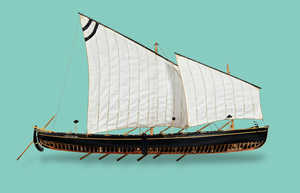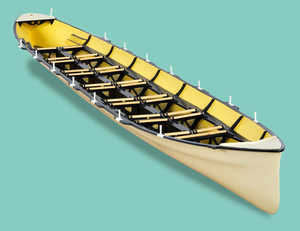Racing trainera
Basque fishermen turned their work into a sport. For centuries,
crews have pitted their oarsmanship against each
other.
Although the coming of steam put an end to the fishing trainera,
it continued to be used for racing. Initially the racing
trainera was no different to its predecessor, but as it was
freed from the restrictions of fishing and sail it rapidly began
to evolve. It still continues to have the same characteristic
outline and a length of 12 metres; however, although the
beam remains the same, the cross-section has been stylised
to the limit of stability and the weight has been reduced
from approximately 800 kg to 200 kg at present, as determined
by the race regulations. From the 1960s on, the traditional
timber construction was replaced by carbon fibre.

Bixente Elizondo at his workshop in Ortzaika, building a trainerilla.
The racing traineras were made in timber until the early
1990s. Despite giving excellent results, they had a service life of
just three years in competition conditions due to the extreme lightness
imposed by the regulations, which set the minimum weight at
two hundred kilos, approximately five times less than the weight of
the crew themselves. © José Lopez

Fishing trainera with part of the rib structure exposed to
view. © José Lopez

Trainera from Elantxobe. Traditional Basque rowing is a demanding
sport. Traineras are very sophisticated vessels, and the crews are
very fit. The classic racing course on the open sea is three nautical
miles in length, a distance that the traineras cover in some-what under
twenty minutes, maintaining an average speed of around nine
knots and reaching spot speeds of up to twelve knots at the start. © José Lopez

Wooden traineras have been supplanted by carbon fibre
boats. The advantage lies not so much in the reduced weight of the
material as in the fact that the boats have greater structural rigidity
than wood, considerably extending their service life. © José Lopez

Bow of a carbon fibre trainera (Sanpedrotarra from Pasaia). © José Lopez

Oil painting by Manuel Losada, depicting a trainera race in the
estuary of the Gernika estuary, with fishing traineras participating,
at a time when the crew was exclusively made up of fishermen.
© photograph: Bilboko Arte Ederren Museoa.

Developments in the design of the racing trainera have centred
on the cross-section or ribs. One can see the great contrast
between the shape of the nineteenth-century fishing trainera and
today's racing trainera. © José Lopez

Developments in the design of the racing trainera have centred
on the cross-section or ribs. One can see the great contrast
between the shape of the nineteenth-century fishing trainera and
today's racing trainera. © José Lopez

Carbon-fibre trainera built at the Amilibia shipyards in Orio.
The results obtained by the new carbon fibre traineras meant that
they were soon introduced more widely. Amilibia’s traineras emergedas
being better than others. They used full shapes above the
waterline, and to some extent were reminiscent of the old fishing
vessels. At the same time, the longevity of the modern traineras and
the impossibility of changing the mould used in their construction
has slowed down any evolution in design. © José Lopez













